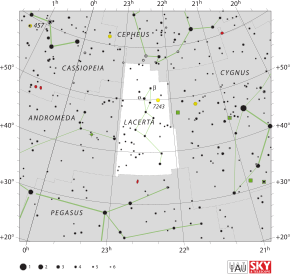
Back Akkedis (sterrebeeld) Afrikaans العظاءة (كوكبة) Arabic لاسيرتا ARZ Lacerta AST Kərtənkələ (bürc) Azerbaijani Кеҫәртке (йондоҙлоҡ) Bashkir Яшчарка (сузор’е) Byelorussian Яшчарка (сузор’е) BE-X-OLD Гущер (съзвездие) Bulgarian গোধা (তারামণ্ডল) Bengali/Bangla
| Constellation | |
 | |
| Abbreviation | Lac |
|---|---|
| Genitive | Lacertae |
| Pronunciation | ⫽læˈkɜːrtə⫽, genitive ⫽læˈkɜːrti⫽ |
| Symbolism | the Lizard |
| Right ascension | 22.5h |
| Declination | +45° |
| Quadrant | NQ4 |
| Area | 201 sq. deg. (68th) |
| Main stars | 5 |
| Bayer/Flamsteed stars | 17 |
| Stars with planets | 12 |
| Stars brighter than 3.00m | 0 |
| Stars within 10.00 pc (32.62 ly) | 1 |
| Brightest star | α Lac (3.76m) |
| Messier objects | 0 |
| Bordering constellations | Andromeda Cassiopeia Cepheus Cygnus Pegasus |
| Visible at latitudes between +90° and −40°. Best visible at 21:00 (9 p.m.) during the month of October. | |
Lacerta is one of the 88 modern constellations defined by the International Astronomical Union. Its name is Latin for lizard. A small, faint constellation, it was defined in 1687 by the astronomer Johannes Hevelius. Its brightest stars form a "W" shape similar to that of Cassiopeia, and it is thus sometimes referred to as 'Little Cassiopeia'. It is located between Cygnus, Cassiopeia and Andromeda on the northern celestial sphere. The northern part lies on the Milky Way.